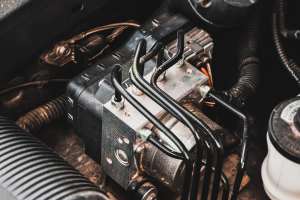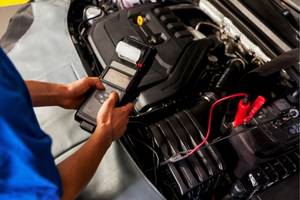Introduction
Welcome to our comprehensive guide on engine computer module (ECM) repair. The ECM, often referred to as the brain of your vehicle, is a critical component that regulates engine performance and efficiency. When it malfunctions, it can lead to a number of problems, leaving your car's health in chaos. Fear not, as this guide will walk you through the process of diagnosing, troubleshooting, and repairing your ECM. Think of it as having a knowledgeable co-pilot by your side, ready to help you at every step.
1. Identify common problems with your engine computer module
Understanding the problem is half the battle won. So, let's play detective and identify the common issues that might signal your ECM is in need of a little TLC.
Engine Performance Issues: If your car starts stalling, misfiring, or the fuel economy drops, the problem could be with your ECM. These are signs that your engine is'nt properly communicating with the ECM.
Check Engine Light: If the check engine light is on and refuses to switch off, it's not being stubborn. It's a distress call from your ECM, signalling potential problems.
Car does'nt start or stalls after starting: If your car is not starting or stops soon after starting, check the ECM (Engine Control Module).
Transmission Problems: The engine control module plays a critical role in the automatic transmission. When it malfunctions, your car may struggle to shift gears smoothly or could shift accidentally. Even minor issues with the ECM can turn your car into a challenge to drive, affecting its transmission system.
Remember, diagnosing the exact problem requires a bit of detective work. But once identified, you're halfway to solving the problem and successfully completing your engine computer module repair. Next up, we'll discuss the tools you'll need in your arsenal to troubleshoot and repair your ECM. So, stay tuned—you've got this!
With the problem identified, it's time arm yourself with the right tools for your engine computer module repair mission. Here's what you need:
Onboard Diagnostic (OBD) Scanner: It is used to convert the Diagnostic Trouble Codes (DTC's) into easy understandable form which your computer generates.
Digital Multimeter (DMM): Digital Multimeter is used in Measuring voltage, continuity, and resistance – which helps in problem identification.
Basic Socket Set: It is needed to disconnect and reconnect the ECM during the repair process. Don't worry; you won't be lifting any heavy engine parts here!
Insulated Screwdrivers: These little heroes will help you in removing and replacing the ECM.
Anti-Static Wrist Strap: Working with electronic components like the ECM can be risky. This tool ensures you don't accidentally zap your ECM with static electricity. Remember, your ECM is sensitive!
With these, you're now ready. Next, we will go through the step-by-step guide to improve your engine computer module. Let the adventure of engine computer module repair begin!
3. Step-by-step guide to troubleshooting your engine computer module
Now it's time to get started. But remember, every repair mission starts with a plan. So, here's a simple roadmap to help you navigate the maze that is engine computer module repair.
Step 1: Connect the OBD Scanner
Firstly connect your OBD scanner to the diagnostic connector in your vehicle. This is generally located under the dashboard. Now, this isn't a guessing game; your vehicle's manual will tell you exactly where to find it.
Step 2: Read and Record the DTCs
Next, power up the scanner and let it do its magic. It'll pull up any DTCs present in your engine computer module. Be sure to jot down these codes - they're the keys to understanding what's wrong with your ECM.
Step 3: Interpret the DTCs
Decoding the DTCs Now onto the fun part! The best part for our sake is that you won't catch yourself deciphering cryptic symbols or Egyptian hieroglyphs. The interwebs are filled with free resources you can use to learn what these codes actually mean when troubleshooting engine computer module repair.
Step 4: Inspect the ECM Physically
Now that you have a general idea of what might be at play, go find out more. Disconnect the ECM with a socket set and a few insulated screwdrivers and check for damage or loose connections.
Step 5: Test the ECM with the Digital Multimeter
Finally, use your DMM to verify if your initial diagnoses were correct. Remember, the DMM is like your best friend in this process, so make sure to use manuals for the correct settings and procedures.
And there you go! A simple guide to improve your engine computer module. Next, we'll search into the gritty details of engine computer module repair. But don't sweat it - armed with these steps, you're already halfway there!
4. Repairing your engine computer module: A detailed guide
Alright, you've done your work, and now it's time to get to work and start the repairs. Remember, patience is key here. Rome wasn't built in a day, and neither will a successful engine computer module repair be. Take your time and follow the steps.
Step 1: Disconnect the Battery
Disconnect the battery when working on your vehicle to prevent shocks. Means to protect you and allows you to start working on the electronics of the car without having any electrical problem. Doing so ensures the integrity of the electrical system and safeguards sensitive equipments.
Step 2: Remove the ECM
Next up, it's time to remove the ECM from your vehicle. You'll typically find it in the engine bay or under the dashboard. Please consult your car owner's manual for a precise spot. After you locate it, take your socket set and unscrew the bolts holding the ECM together on the car. Remove all of the connectors, and your ECM is finally free.
Step 3: Open the ECM
Now it's time to disclose the heart of the matter. Use your insulated screwdrivers to open the ECM case. Be gentle; you don't want to cause any additional damage!
Step 4: Repair the ECM
Now, what you'll need to do here depends on what your troubleshooting process revealed. If there's a damaged circuit, you might need to solder a new one in place. If there's a loose connection, perhaps a bit of tightening is all it needs. Remember, every engine computer module repair is unique, so follow the guidance of your DTCs and your own observations.
Step 5: Put back everything
After your repair is completed, it is time to reassemble everything. Install the ECM cover, reassemble in vehicle, connect connectors, reconnect battery.
And there you have it, a detailed guide to tackling engine computer module repair. So the next time your engine gives you some trouble, you know just what to do. You can avoid these issues with maintenance. Well, now that you know what an engine computer module is, how it works, and where it is; lets see some useful maintenance tips about your engine computer module shall we?
5. Tips for maintaining your engine computer module
Now you have some idea of how to repair the engine computer module so it would be good if these problems do not happen. Of course, it would! So, let's talk about some handy maintenance tips to keep your ECM in top shape.
Tip 1: Regular Diagnostics
The first rule of ECM maintenance is never to ignore check engine light. The best defence you have against any possible problems is that little light. Even when things appear wonderful, develop a practice of conducting routine diagnostics on your car. The sooner it is caught, the easier it will be to fix and often prevents those expensive repair costs.
Tip 2: Keep it Clean
Connections breaking down over time, due to dirt and grime are a common reason for faults and failures. Check your oil all by yourself and regular engine bay cleaning will help keep your ECM clean and the rest of your engine running smoothly.
Tip 3: Protect from Extreme Temperatures
Both extreme cold and heat can harm sensitive electronics. If you can, park in a garage or shade to protect your vehicle.
Tip 4: Regular Vehicle Maintenance
Last but not least, regular vehicle maintenance can do wonders for your ECM. Regular oil changes, filter replacements, and general check-ups can help keep your entire vehicle, including the ECM, in top condition.
So now, not only can you deal with just about every engine computer module repair there is you can even protect against those repairs being necessary in the first place. Because remember, prevention is better than cure. Follow these tips, and your ECM—and your car—will more than appreciate it.
Conclusion
Repairing your engine computer module might seem difficult, but with the right guidance and tools, it's a manageable task. By following this guide, you'll be equipped to diagnose and fix common ECM issues, ensuring your vehicle runs smoothly. Regular maintenance and immediate attention to warning signs can help you avoid costly repairs in the future. Remember, understanding your ECM and how it works empowers you to keep your car in top shape. Happy driving!
FAQs on
Engine Computer Module Repair in 2025 : Comprehensive Guide
-
1. What is an Engine Computer Module (ECM)?
Ans.
The ECM, or Engine Control Module, is the electronic unit responsible for managing engine functions and ensuring optimal performance and efficiency.
-
2. What are common signs of ECM failure?
Ans.
Symptoms of ECM failure include engine performance issues like stalling, misfiring, poor fuel economy, the check engine light being on, starting problems, and transmission difficulties.
-
3. Can I repair my ECM myself?
Ans.
Yes, with the right tools and guidance, you can troubleshoot and repair your ECM. This guide provides a step-by-step process to help you through the repair journey.
-
4. What tools do I need for ECM repair?
Ans.
Essential tools for ECM repair include an Onboard Diagnostic (OBD) scanner, digital multimeter, basic socket set, insulated screwdrivers, and an anti-static wrist strap.
-
5. How often should I perform maintenance on my ECM?
Ans.
Regular diagnostics, keeping the engine bay clean, protecting the ECM from extreme temperatures, and adhering to routine vehicle maintenance can help ensure your ECM remains in good condition.
-
6. What should I do if my check engine light comes on?
Ans.
If your check engine light comes on, use an OBD scanner to retrieve Diagnostic Trouble Codes (DTCs) and investigate the issue promptly to prevent further damage.


